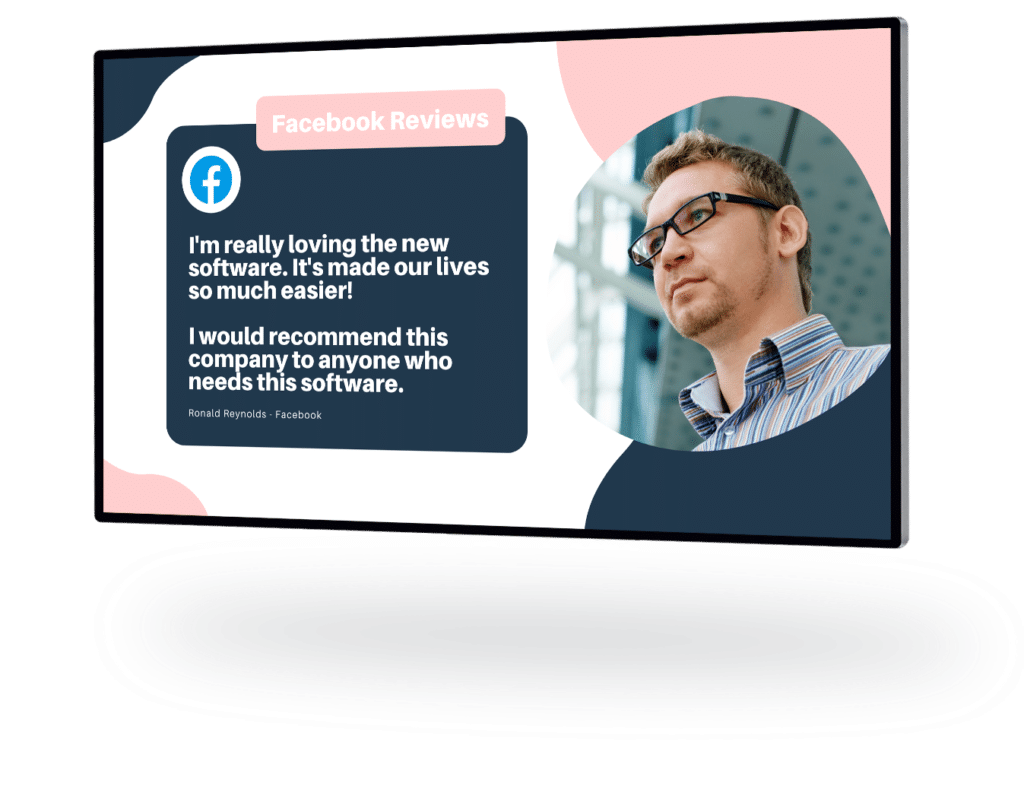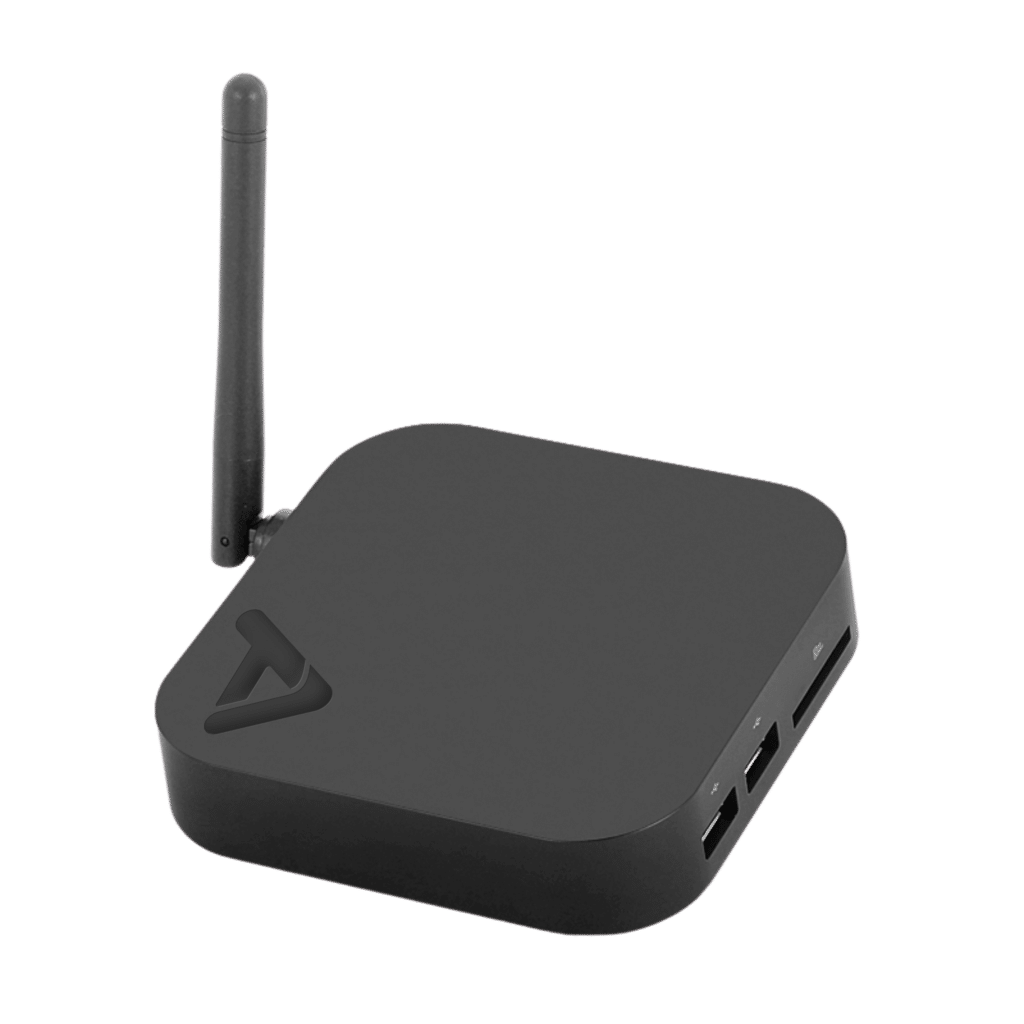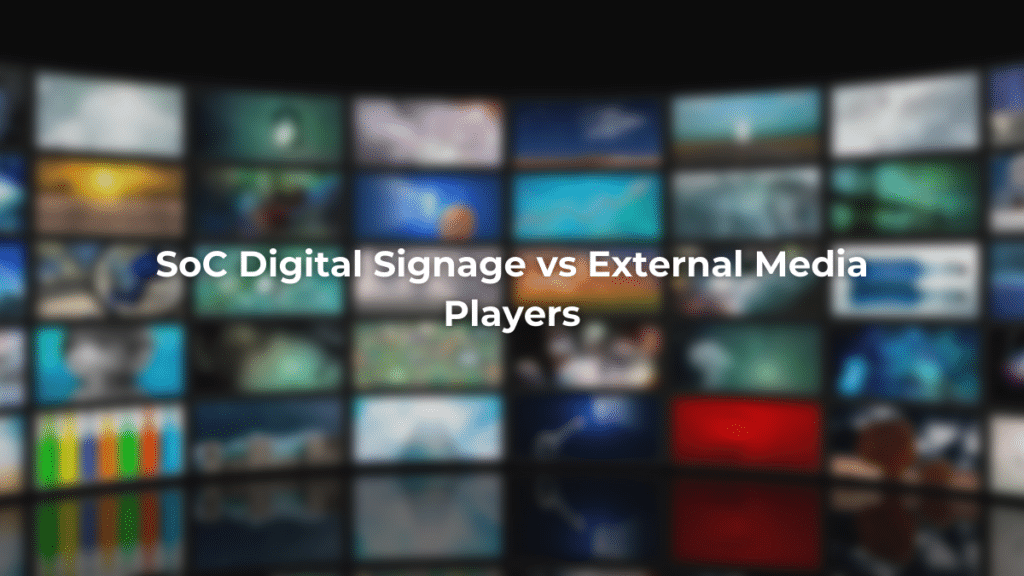SoC digital signage versus external media players. The age-old digital signage debate!
So. You’re starting a digital signage project and are looking for a way to deliver your content to your screens. There are two main choices here, an SoC (system on chip) display, or an external media player. Both choices come with their own features and benefits that will ultimately shape your decision.
Within a digital signage project you have 3 main components:
- Software – Where you upload, create, schedule, and deploy your content.
- Media player/SoC display – The device that pulls your content from the software and plays it on your screen.
- Screens – Displays content to your audience at a given location.
From our numbered list above, you can think of the media player/SoC display as the mediator between your software and screens. Without it, you can’t display your content on the screen.
In this blog we compare SoC digital signage against external media players and see how they stack up against each other.
What is SoC Digital Signage?
SoC digital signage or system on chip screens are standard displays with an integrated processor chip. The integrated chip comes with built-in digital signage software, allowing you to control your on-screen content. As an “all in one display”, these screens are often considered sleek as they require fewer wires within a digital signage project and don’t require an additional device.

What is an External Media Player?
An external media player is a small computer that takes content from your digital signage software and displays it on screen. Often in the form of a small black box, external media players can be hidden behind your screens and out of sight. In most cases, external media players are simply plug-and-play. All a user needs to do is plug their media player into a plug socket, and connect it to the internet. Within seconds content will start playing on the screen.

Performance
The performance of your content delivery device is critical in ensuring a successful digital signage project.
When we talk about performance we essentially mean how well does the content run? Is it smooth or jagged? Does the content load quickly or is there a delay? It’s important to bear in mind what kind of content you are looking to display and how important the speed of content delivery is. If you want your screens to display high-quality or more complex content such as live data dashboards, 4k videos, etc. you will need to ensure your screen or external device is powerful enough to keep content running smoothly. However, if your project consists of only displaying simple content such as plain text or images, you may be okay with something less powerful.
Depending on the goals of your digital signage project, these are key points to keep in mind when choosing between SoC digital signage or an external media player. Inadequate power can cause your content to fail, turning off your audience and reducing the effectiveness of your screens.
SoC Digital Signage Performance
Out of SoC digital signage and external media players, SoC displays tend to fall on the lower side of power. However, thanks to more powerful processors most content will run smoothly with minimal issue. Although SoC screens have improved massively in recent years, they can still be unreliable when it comes to displaying more complex content.
We’ve found that the biggest indicator of performance can be content load times. In our video below we tested an SoC digital signage display vs a commercial-grade display utilising an external media player. Both screens are loading the same content over the same network. However, the external media player proves to be a clear winner in terms of performance.
External Media Players Performance
External media players are often the most popular choice when it comes to digital signage content delivery. They have proved to be reliable and are often able to handle any kind of content its users throw at them.
The reliability of an external media player stems from the ability to tailor a media player to a certain project. If a user is only planning on displaying simple content, a standard, or a more cost-effective media player can be used. However, if the user wants to display something more advance or even wants to control a video wall, more powerful external media players can be sourced.
Check out the video below for a side by side comparison of load times for SoC (left) vs and external media player (right).
We also tested the screens using more complex content. The content in the video below involved live templates, scrolling text, and a live newsfeed. This content and features are commonly used by digital signage users.
You can see that the external media player (right) performs far better than the SoC display (left). It’s evident the SoC display is struggling here and the content isn’t playing smoothly.
Aesthetics
Digital signage is a highly visual marketing and communications channel. The effectiveness and success of your screens not only depends on the content you display but how good the hardware (screens and media players) looks.
In most cases, digital signage users want their digital signage projects to look as clean as possible. This means attractive-looking screens and hidden wires. Having a poorly installed or messy-looking project can completely turn off your intended audience. However, a seamless integration can be a real eye-catcher, drawing more attention to your content.
SoC Digital Signage Aesthetics
When it comes to looking good, SoC displays are often thought of as the victor. Through utilising a built-in processor, SoC displays are essentially an all-in-one system. All a user needs to do is plug their screen into a power source and connect it to the internet. There are no additional cables (except a potential ethernet cable) to be plugged in. This can allow for a completely seamless installation with minimal worry for cable management.
As SoC displays are essentially a standard screen with a powerful processor built-in, they look like a normal display. They’re not extra bulky to compensate the chip, keeping them sleek.
External Media Players Aesthetics
Although an additional device, external media players still offer a sleek integration to any project. Thanks to their size, the media player can be hidden nicely behind the display.
With using an external media player however, the user will have extra cables to deal with/hide. However, this can be accomplished with some simple cable management techniques.
Check out an example of an external media player being used covertly below. Laing jewellers have cleverly hidden media players behind their screens within a custom-sized frame.
Support
We hope things don’t need fixing, but if they do, you want it done simply and quickly. A successful digital signage project maximises screen uptime, making sure your content is seen by your audience at all times. Therefore, having good support is critical. But how does support fare for each type of method of content delivery?
SoC Digital Signage Support
At its core, support for SoC digital signage is okay. Like external media players, Team Viewer can easily be installed. Therefore, allowing support teams to jump on and solve any software issues your screens experience.
Hardware issues however are a different kettle of fish. If there is a hardware issue, i.e. the software fails, the screen is broken, etc. the whole screen will need replacing. This will come at an extra cost to the user.
External Media Player Support
Support for external media players is solid. For software issues, Team Viewer can be installed allowing support teams to download software and fix issues remotely.
For hardware issues, things remain simple. If your media player gets broken, it can simply be swapped out. All you need to do is contact your digital signage supplier and ask for a new media player. Your supplier will send it out and all you’ll need to do is reconnect it to your screen. If the screen itself suffers an issue, you’ll only need to replace the screen. Still a pain, however, you don’t lose the cost of the media player here, like you would with an SoC display.
Price
Price is often the largest consideration for most digital signage projects. Users want to ensure that they are getting good value for money. However, they also want to ensure they are getting good performance too.
SoC Digital Signage Price
In comparison to standard displays, SoC displays come at a larger cost. This is often due to them being an all in one solution resulting in a smoother installation.
In the long run however, some people argue that an SoC display can save users money. By having an all in one solution, the digital signage system can operate more efficiently, using less electricity in the process. This can also be a great feature for organisations looking to operate more eco-friendly.
The cost of an SoC digital signage display can also be elevated by replacing hardware. As mentioned previously, if your screen needs replacing, you will need to essentially pay for both the screen and the content driver (integrated chip).
External Media Player Price
For most projects, and external media player is the victor when it comes down to cost. Different media players can be sourced for different levels of content. E.g. if you only wanted to play simple content, you could opt for a less powerful media player at a lower cost.
Another benefit of using external media players in your project is the cost of repair and replacement. If something, unfortunately, goes wrong, all a user needs to do is swap out their media player or change their screen. This means the user is only paying out for one component, not two.
Overall, the form of content delivery you choose will depend on your project and budget. Each type has its own benefits and weaknesses, which will need to be considered when making your choice. Ultimately, it’s always best to discuss this with your digital signage provider.
If you have any questions regarding SoC digital signage, speak to an expert today. Call our friendly team on 02380 981110 or Email info@troudigital.com for a no-obligation consultation. Alternatively, click the button below.
